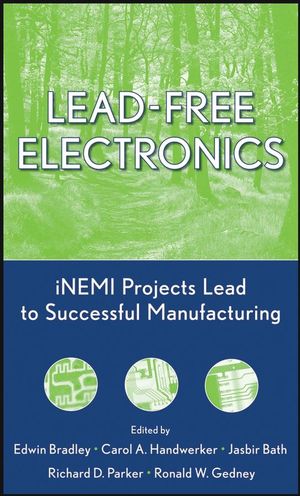Lead-Free Electronics: iNEMI Projects Lead to Successful ManufacturingISBN: 978-0-471-44887-7
Hardcover
472 pages
October 2007, Wiley-IEEE Press
 |
||||||
Contributors.
Introduction (Jasbir Bath and Carol A. Handwerker).
Lead-Free Assembly Project.
Alloy Group.
Process Group.
Component Group.
Reliability Group.
Follow-On Projects/Work.
1. Alloy Selection (Carol A. Handwerker, Ursula Kattner, Kilwon Moon, Jasbir Bath, Edwin Bradley, and Polina Snugovsky).
1.1. Introduction.
1.2. Lead-Free Alloys Considered by iNEMI in 1999 as Replacements for Tin–Lead Eutectic Solder.
1.3. Fundamental Properties of Lead-Free Solder Alloys Affecting Manufacturing and Reliability.
1.4. R&D Issues Remaining in Lead-Free Solder Implementation.
1.5. Summary.
References.
2. Review and Analysis of Lead-Free Solder Material Properties (Jean-Paul Clech).
2.1. Introduction.
2.2. Tin–Lead Properties and Models.
2.3. Tin–Silver Properties and Creep Data.
2.4. Tin–Silver–Copper Properties and Creep Data.
2.5. Alloy Comparisons.
2.6. General Conclusions/Recommendations.
Appendix A: Tin–Silver Creep Data.
Appendix B: Tin–Silver–Copper Creep Data.
Acknowledgments.
References.
3. Lead-Free Solder Paste Technology (Ning-Cheng Lee).
3.1. Introduction.
3.2. Materials.
3.3. Rheology.
3.4. Applications.
3.5. Reflow Soldering.
3.6. Microstructures of Reflowed Joints.
3.7. Challenges of Lead-Free Reflow Soldering.
3.8. Summary.
References.
4. Impact of Elevated Reflow Temperatures on Component Performance (Richard D. Parker, Jack MCCullen, Nick Lycoudes, and R. J. Arvikar).
4.1. Introduction to Component “Lead-Free” Issues.
4.2. Moisture/Reflow Impact on Packaged Integrated Circuits.
4.3. Impact of Increased Solder Peak Reflow Temperatures on Moisture Sensitivity Level Ratings.
4.4. Impact of Increased Solder Peak Reflow Temperatures.
4.5. Observations on Profiling for the Lead-Free Reflow Processes.
4.6. IC Package Improvement Options for Better Package MSL at Higher Lead-Free Solder Reflow Temperatures.
4.7. Frequency Control Products.
4.8. “Lead-Free” Cost Impact on Components.
4.9. Packaging Identification of Lead-free Packaged ICs.
4.10. Conclusions.
Acknowledgments.
References.
5. Lead-Free Assembly Reliability—General (Edwin
Bradley).
5.1. Introduction.
5.2. Basic Physical Properties of Solder.
5.3. Creep Deformation.
5.4. Thermal Fatigue.
5.5. Creep Rupture.
5.6. Isothermal (Mechanical) Fatigue.
5.7. Out-of-Plane Bending.
5.8. Impact/Shock Loading.
5.9. Effect of Rework on Reliability.
5.10. High-Temperature Operating Life (HTOL).
5.11. Electrochemical Migration.
5.12. Tin Whiskering.
5.13. Tin Pest.
5.14. Summary.
Acknowledgments.
References.
6. Lead-Free Assembly Reliability: iNEMI Evaluation and Results (Elizabeth Benedetto and John Sohn).
6.1. Reliability Team Goals.
6.2. Reliability Test Matrix.
6.3. Component-Paste-Board Finish Combinations.
6.4. Components.
6.5. Test Vehicles.
6.6. Pre-Test/Post-Assembly Information.
6.7. CTE Determination: Component and Boards.
6.8. Thermal Cycling Conditions.
6.9. Failure Criteria.
6.10. Thermal Cycle Relative Performance.
6.11. Failure Data, Analysis Packages.
6.12. Weibull Analyses.
6.13. Post-Cycling Failure Analysis.
6.14. Bend Testing.
6.15. Electrochemical Migration Testing [36, 37].
6.16. iNEMI Team Conclusions.
6.17. Overall Summary, Conclusions.
6.18. ASTM Test Methods.
References.
7. Tin Whiskers: Mitigation Strategies and Testing (Heidi L. Reynolds, C. J. Lee, and Joe Smetana).
7.1. Introduction.
7.2. Mitigation Strategies.
7.3. Tin Whisker Test Development.
7.4. Summary.
Acknowledgments.
References.
8. Lead-Free Reflow and Rework (Jasbir Bath).
8.1. Introduction.
8.2. Printability of Lead-Free Solder Pastes.
8.3. Soak Versus Ramp Temperature Profiles.
8.4. Effect of Peak Temperature Versus Reflow Performance.
8.5. Effect of Reflow Atmosphere on Solderability of Lead-Free Solder.
8.6. Convection Versus IR Reflow Ovens.
8.7. Reflow Temperature Delta on Boards and Components.
8.8. Visual Inspection of Lead-Free Soldered Joints.
8.9. Automated Optical Inspection (AOI).
8.10. X-ray Inspection of Lead-Free Soldered Joints.
8.11. Acoustic Microscopy Inspection of Components Before and After Lead-Free Reflow.
8.12. Lead-Free Rework of BGA/CSP Soldered Joints.
8.13. Lead-Free Hand-Soldering Rework.
8.14. In-Circuit Testing and Functional Testing (ICT/FT) of Soldered Joints.
8.15. Yield Data.
8.16. Surface-Mount Fillet Lifting and Reliability of Reflowed Soldered Joints.
8.17. Conclusions.
8.18. Future Work.
Acknowledgments.
References.
9. Case Study: Pb-Free Assembly, Rework, and Reliability
Analysis of IPC Class 2 Assemblies (Jerry Gleason, Charlie
Reynolds, Matt Kelly, Jasbir Bath, Quyen Chu, Ken Lyjak, and
Patrick Roubaud).
9.1. Introduction.
9.2. Approach and Strategy.
9.3. Observations and Results.
9.4. Conclusions.
9.5. Summary.
Acknowledgments.
References.
10. Implementing RoHS and WEEE-Compliant Products (Jim MCElroy and Cynthia Williams).
10.1. Introduction.
10.2. Are Your Products within the Scope of the EU ROHS?
10.3. Ten Steps to ROHS Compliance.
10.4. Part Numbering Important for Differentiating Lead-Free from Tin–Lead Components and Boards.
10.5. A Standards-Based Approach to Materials Declaration.
10.6. Standards.
10.7. High-Reliability Requirements.
10.8. Business Impact of Supply Chain Conversion.
10.9. Summary.
References.
Index.



